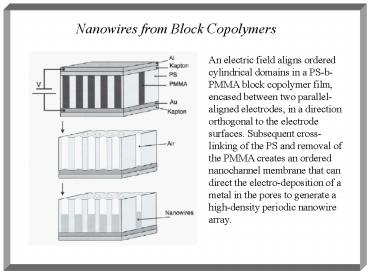MILOS IADR PowerPoint PPT Presentation
1 / 12
Title: MILOS IADR
1
Nanowires from Block Copolymers
An electric field aligns ordered cylindrical
domains in a PS-b-PMMA block copolymer film,
encased between two parallel-aligned electrodes,
in a direction orthogonal to the electrode
surfaces. Subsequent cross-linking of the PS and
removal of the PMMA creates an ordered
nanochannel membrane that can direct the
electro-deposition of a metal in the pores to
generate a high-density periodic nanowire array.
2
Making Micelles
A series of polystyrene-b-polyacrylic acid
(PS-PAA) block copolymer with long PS blocks and
short PAA blocks can be dissolved in water.
The assembly of such polymer is highly dependent
on the relative molecular weight of the two
blocks. At a 20021 block ratio of PS to PAA,
the PAA-terminated solid PS spheres are
assembled. When the PAA segment is reduced to
15, worm-like micelles are self-assembled.
Further decreasing the PAA length to 8, the
system assembles into hollow spheres having a PAA
corona on the outside and inside of the capsule.
3
Assembling Inorganic Polymers
Anionic polymerization is a viable strategy to
synthesize block copolymers containing
polyferrocenylsilane (PFS) segments.
PFS-b-poly(dimethylsiloxane) (PDMS) copolymers
can self-assemble into rods or wire-shaped
micelles. The structure and morphology of these
assemblies are interesting as they have an
iron-bearing polymer core and an outer sheath of
PDMS. Controlled redox chemistry can provide an
oxidized PFS core, known to be semiconducting,
which can be interesting as active elements or
interconnects in nanoscale electronic devices.
Post-treatment has also been used to transform
the rod micelles into nanoscale wires with
tailorable magnetic properties and high aspect
ratios.
4
Self-Assembly of Rod-Coil Block Copolymers
Rod-coil block copolymers consist of a rigid
segment of rod with low mobility and a flexible
segment which has a random coil conformation.
This type of copolymer can self-assemble in a
solvent that has an affinity for the coil
component to form micron diameter hollow
spherical micellar-type constructs.
Casting and self-assembly of a rod-coil
poly(phenylquinoline)-b-polystyrene (PPQmPSn)
block copolymer from carbon disulfide gives a
macroporous polymer film periodic at the light
scale, enabling it to function as a photonic
crystal that Bragg diffracts light
5
Self-Assembly of Large Building Blocks
6
By viewing self-assembly as a map of forces
acting over multiple length scales, it is
possible to imagine a wide range of interactions
that could auto-construct building blocks larger
than a micron into functional architectures. The
interactions include electric, magnetic,
colloidal and capillary forces. These
interactions usually are not considered
particularly useful in the chemical approach to
manipulating matter, but they are powerful for
organizing and assembling large building blocks
in fluid phases, at interfaces and in confined
spaces. The assembly of large building blocks is
not as abstract as it may initially seem.
Countless common phenomena are based on
self-assembly, such as the crystallization of
molecular materials, growth of epitaxial layers
in microchip manufacture and the folding of
proteins after their manufacture in living cells.
The use of large units, which mimic the behavior
of atoms and molecules in these systems, can
allow us to test various assembly models with
easily detectable and rigorously defined
responses.
7
Synthesis Using the Capillary Force/Bond
Capillary interactions between large building
blocks can be utilized to conduct self-assembly.
Capillary force/bond can be tailored through
chemical control of their hydrophobic/hydrophilic
properties. It is possible to design the
surfaces of large building blocks to cause them
to either attract or repel when floating at a
fluid-fluid or fluid-air interface, or suspended
in an iso-dense fluid.
An illustration of how micron- or
millimeter-scale building blocks can assemble at
air-liquid and liquid-liquid interfaces, as well
as in solution, through capillary interaction
8
Crystallizing Large Polyhedral Building Blocks
Capillary-driven self-assembly can crystallize
millimeter-sized building blocks into regular, 3D
arrays with open structures.
Polyhedral building blocks are made from molded
polyurethane and particular faces are covered
with copper tape wet by a film of low-melting
solder. The polyhedrons are shaken in an
iso-dense KBr solution heated above the solder
melting point to cause self-assembly into
equilibrium structures. Capillary forces between
molten solder surfaces on the polyhedral units
cause them to self-assemble into a regular open
structure, polyhedral crystals, the structure of
which is controlled by the particular polyhedral
shape and location of solder-coated surfaces.
9
Self-Assembling 2D and 3D Electrical Circuits and
Devices
Capillary-guided self-assembly of large building
blocks has been expanded to include polyurethane
polyhedrons with surfaces patterned with solder
dots, wires and light emitting diodes (LEDs) and
self-assembled to electrically functional 3D
networks.
A fully addressable cylindrical display made by
capillary driven patterned assembly of GaAlAs
cube-shaped LEDs. The figure shows the
activation of LEDs in various configurations on
this display.
10
Crystallizing Micron-Sized Planar Building Blocks
Metal plates with hexagonal shapes made by
photolithography have been self-assembled into
regular 3D arrays. The procedure for making the
shapes and assembling them is shown below. The
example concerns 10-micron Cr(OH)-Au(CH3)-Cr(OH)
plates where this notation describes the terminal
functional groups on the bottom, side and top
surfaces of the plates, respectively.
11
Large Sphere Building Block Self-Assemble into 3D
Crystals
Confined crystallization in columnar wells has
been adopted to generate regular 3D arrays of
large millimeter dimension spherical building
blocks. The orientation and arrangement of the
spheres in the columns can be predetermined, by
tailoring the sphere diameter with respect to the
colume cross-sectional size and shape.
This methodology is useful for making highly
symmetric sphere lattices (cubic, hexagonal,
tetragonal or orthorhombic) with lattice
dimensions that could find utility as microwave
photonic crystal devices.
12
Supplemental Reading Materials
- Geoffrey OA, Arsenault AC (2005). Chapter 3
Layer-by-Layer Self Assmbly, Chapter 9
Self-Assembly Block Copolymers, and Chapter 11
Self-Assembly of Large Building Blocks, in
Nanochemistry A Chemistry Approach to
Nanomaterials, RSC Publishing, Cambridge, UK.

